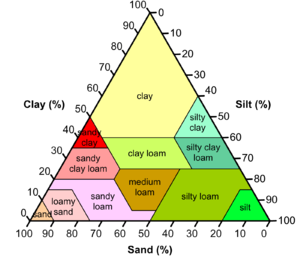Understanding the role that soil plays in the garden is one of the best assets that you can have as a gardener. It is this knowledge that will allow you to create a healthier environment for your plants and get the maximum benefits from them.
In doing so, you will also make your own life easier, as a garden that is well managed from the soil up, is a garden that is a lot easier to manage from one day to the next.
| Soil types by clay, silt and sand composition. (Photo credit: Wikipedia) |
So how do you get good soil?
First you need to consider how plants grow and how they get their nutrition and that is through their roots. Therefore, in order for the plants to grow well, they need to be in soil that allows their roots to get to the nutrition.
Obviously very compact ground with little water, little air and poor nutrition will not produce the best plants. Plants need water and air and this requires soil that has spaces to hold this air and water. Therefore soil that is properly aerated will generally produce a better garden.
But once again (as all things with gardening) it is all about balance, as soil that is too crumbly might not hold the nutrients as well, so the water might wash them away. The soil also needs to be firm enough to support the growth of the plant - otherwise it will topple over at the first sign of a wind.
The soil needs to have suitable nutrients and if any of these nutrients are out of balance, a pH scale that measures whether the soil is acidic or alkaline will show why plants are having difficulty absorbing the nutrients.
Be sure to check back next week when we'll discuss soil pH in further detail.


No comments:
Post a Comment